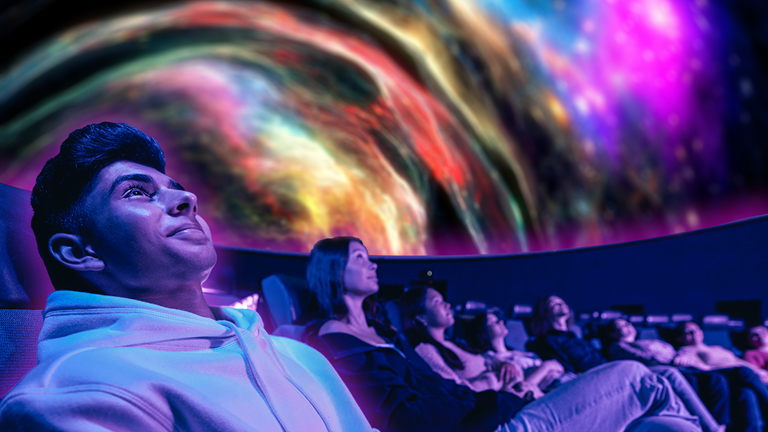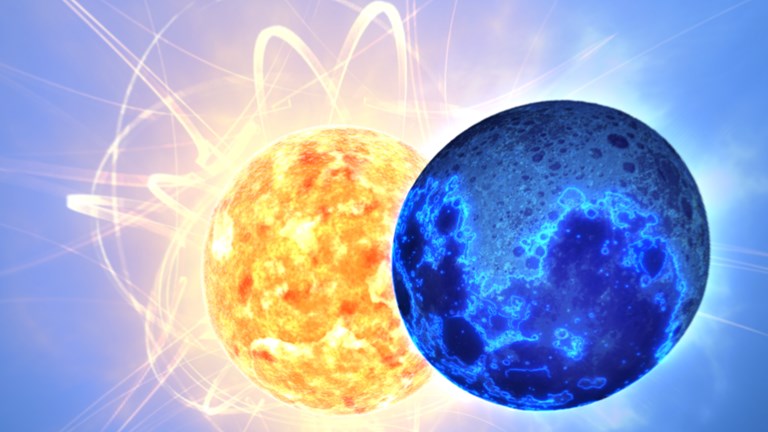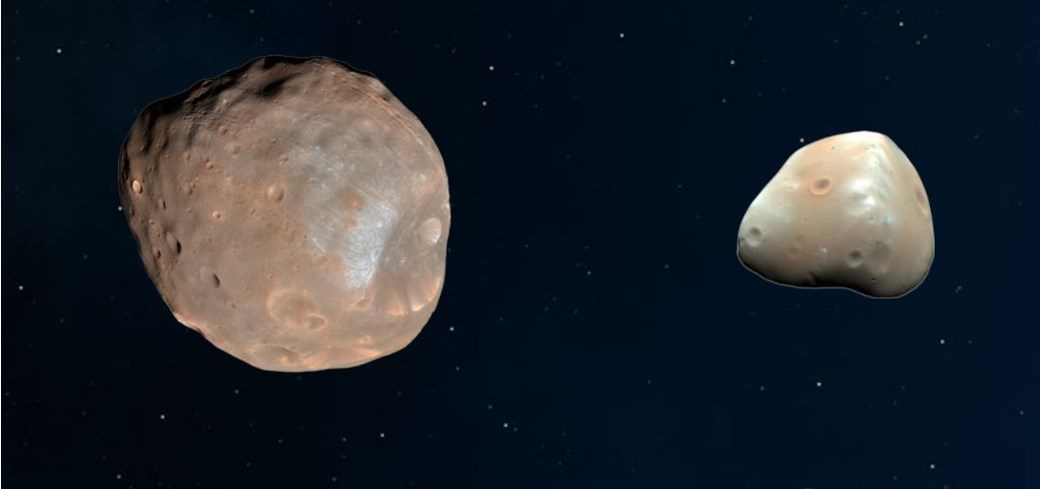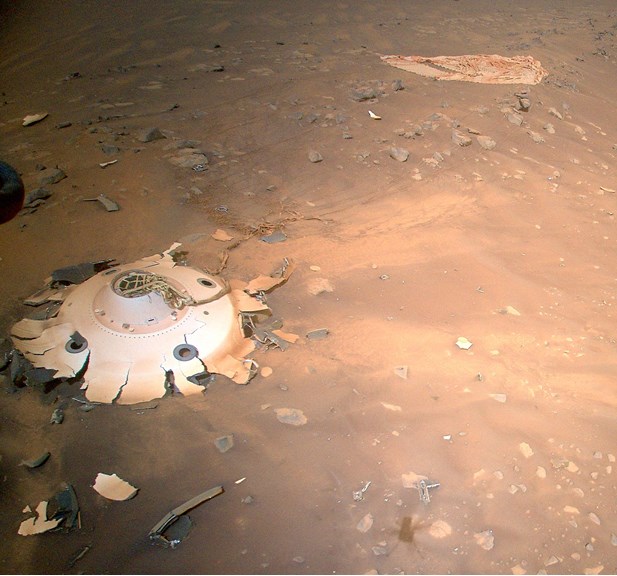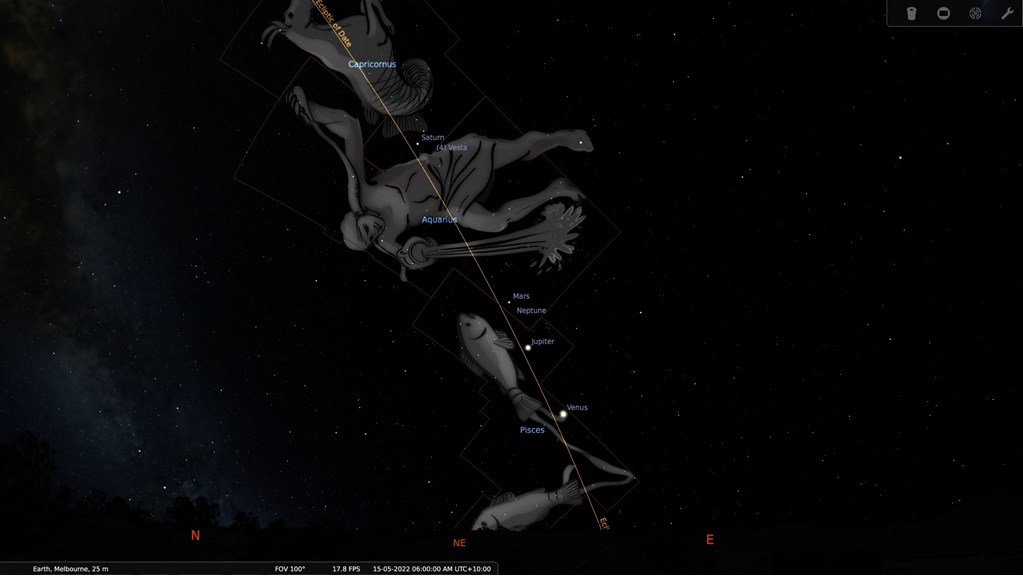Skynotes: May 2022
Upcoming events
Martian wonder as Phobos transits the Sun
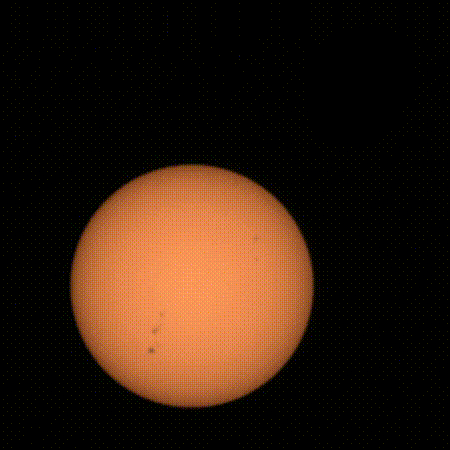
NASA/JPL-Caltech/ASU/MSSS/SSI
After over 400 Martian days or sols on the Red Planet exploring Jezero Crater, NASA’s Perseverance Rover using its Mastcam-Z camera has recently captured to date the highest frame rate and resolution video of Mars’ moon Phobos passing in front of the Sun.
The roughly potato-shaped inner moon has been seen in transit before by NASA’s Curiosity rover but not in colour and with such detail as this latest video which even includes sun spots.
The Moons of Mars
(adapted from Skynotes 2020)
Our neighbour has some weird moons. If you were to stand on the red sands of Mars you might gaze in wonder as its two amazing satellites go by.
Phobos, the larger of Mars’ two moons, is oblong with a major axis of 27km. At 6,000 km it has a speedy orbit completing a pass every 8 hours, or three for each Martian day (which is a little over 24 and half Earth hours). It would appear a third the size of the Moon as seen from Earth.
Counterintuitively, due to its speedy orbit and Mars’ rotation, it would locally seem to rise in the west and set in the east even though the planet rotates to the east like Earth.
Smaller Deimos is much further out at 23,000 km taking 30 hours to orbit the planet. By comparison, our giant slow Moon is 3,475 km in diameter at an average distance of 384,400km, takes 27 days to orbit Earth, and is always seen rising in the east and setting in the west.
Both moons seem to be lumpy cratered asteroids caught in Mars’ gravity with both having only one side facing the Red Planet. They could be a convenient staging post to the planet below or serve as observation or communications platforms, if their surfaces prove stable enough.
And their names? The Roman god of war was Mars, but his Greek counterpart Aries had two fierce horses, Phobos and Deimos, that pulled his war chariot into battle. When the two little moons were discovered in 1877 they were fittingly given names evoking panic, terror and dread.
The fate of Phobos is to move in an ever-tightening orbit getting closer to Mars by a couple of metres every century. In some 50 million years it will cross a dynamic threshold known as the Roche Limit and break up giving Mars a dusty or rocky ring for future eyes to behold. A ghostly relic leaving only little Deimos in high orbit as the last of Mars’ weird potato moons.
Enjoy:
Ingenuity snaps Mars mission hardware
NASA's Ingenuity helicopter has flown several hundred metres to the location of the mission's backshell and parachute from Perseverance Rover's landing on Mars in February 2021.
Already seen at a distance by Perseverance's cameras, the helicopter has now visited the site and photographed the mission components in detail from a height of eight metres.
After protecting the rover and descent stage en route to Mars and during the high speed (20,000 km/h) entry into Mars' thin atmosphere, the protective backshell with parachute was jettisoned in the last moments before the rover and descent stage made their final and dramatic ‘sky crane’ manoeuvre for the rover's safe touchdown in February 2021.
The descent stage separated from the rover in the last seconds before touchdown and powered away to crash safely far from the rover. While one of Perseverance's cameras caught an image of the distant crash plume, and the site has been imaged from orbit, the discarded descent stage perhaps 1km from the rover has not (yet) been visited by Ingenuity, the remarkable Martian helicopter.
Melbourne Sun times
| Date | Rise | Set | Day length | Solar noon§ |
|---|---|---|---|---|
| Sun 1st | 7:00 | 5:33 | 10:32 hrs | 12:17 |
| Wed 11th | 7:09 | 5:23 | 10:13 hrs | 12:16 |
| Sat 21st | 7:18 | 5:15 | 9:56 hrs | 12:16 |
| Tue 31st | 7:25 | 5:09 | 9:44 hrs | 12:17 |
§ When the sun is at its highest, crossing the meridian or local longitude.
Moon phases
| Phase | Date |
|---|---|
| New Moon | Sun 1st |
| First Quarter | Mon 9th |
| Full Moon | Mon 16th |
| Third Quarter | Mon 23rd |
Moon distances
Mon 2nd is lunar apogee (furthest from Earth) at 406,192 km.
Wed 18th is lunar perigee (nearest to Earth) at 360,298 km.
Planets
Early morning planets all this month!
As you may have observed last month, a wonderful line-up of planets in the east before dawn continues into May. As the month progresses Saturn will lead rising shortly after midnight followed by Mars from around 2am. Jupiter then makes its appearance shortly after 3am with Venus from around 3.30am.
By 5am all four will be lined up until Saturn fades in the early dawn light followed by Mars, then Jupiter as sunrise approaches. Lastly, Venus, the brightest object in the night sky after the moon, will fade from view shortly before sunrise.
Mercury is too close to the Sun to be seen from Melbourne this month, but by the middle of June it too will rise in the east shortly before sunrise.
Depending where they are in their orbits, planets can at times be spread along the ecliptic during the night, or have risen during the day and so invisible, or even be temporarily passing behind the Sun. Last month and this month our morning view looking north-east encompasses our closest neighbours Venus and Mars, and much further out Jupiter and Saturn.
During May Jupiter will gradually draw higher each morning towards the Red Planet, while Venus will descend towards the horizon. And from the 20th onwards the Moon will join the morning line-up as it transitions through its Third Quarter phase.
The planets are ‘wanderers’ (planeta from ancient Greek) moving along their orbits such that night by night we see them shift their positions against the fixed background of distant stars. The closer a planet is to the Sun the faster it orbits (and the shorter its year), and the further out the slower it is (and the longer its year). For this reason, the nightly change of position of inner planets like Mars and Venus will be more obvious than the outer planets Jupiter and Saturn.
Venus and Jupiter are in Pisces this month, Mars sits in Aquarius and Saturn is high in Capricorn – all in the north-east before dawn as depicted here in Stellarium for 6am on May 15. The yellow line is the ecliptic close to or on which the planets are found. Distant Neptune is marked and Vesta in the asteroid belt.
Meteors
The Eta Aquarids meteor shower begins on the 3rd peaking on the 6th. The shower is linked to Comet Halley and rates can reach 55 meteors per hour. They are sand or rice grain size, very fast at 64km/sec, usually yellow with persistent trains, and enter the atmosphere 100km above the surface. They appear in the constellation Aquarius, and the radiant, or point from which they appear to originate, rises at 2.30am moving higher to the north-east by dawn.
Stars and constellations
In the west
The brightest star in the night sky, Sirius, is high in the west and forms the principal star in Canis Major (Greater Dog), a companion to Orion, the hunter who lies below much closer to the western horizon and appears almost upside down from our southern hemisphere view. Marking one of his shoulders is Betelguese, a very obvious red giant star, and diagonally across Orion to the upper left is Rigel, a blue supergiant star that makes a contrast. The three bright stars that form an almost vertical line in the centre of Orion are his belt. His belt is also the base of the ‘Saucepan’ asterism. His scabbard or sword that angles up from his belt forms the saucepan’s handle. In the centre of the handle or sword/scabbard is a fuzzy greenish object which binoculars or telescopes will reveal as the glorious Orion Nebula some 1300 light years from us – a vast cloud of gas and dust where young stars are forming.
Above and to the south of Sirius is Canopus, the second brightest star in the night sky which belongs to the constellation Carina (the keel).
In the north
In the north is the constellation of Leo, the lion. Leo is upside down compared to the northern hemisphere. Look for an upside-down question mark as his head and mane. The brightest star in Leo is Regulus, meaning ‘little king’.
In the south-east
The large and impressive constellation of Scorpius can now be seen rising horizontally in the south-east with its head and pincers reaching east and the long curving tail stretching to the south. The scorpion's heart is marked by the red star Antares. This is a very rich area of the Milky Way and the scorpion's tail contains beautiful star clusters that can be seen with binoculars.
The two bright Pointers (Alpha and Beta Centauri in the constellation of Centaurus) are low in the south-east and lead your eye up to the smallest constellation astronomers use – Crux (or Southern Cross) which sits on its side this month and easily recognisable.
In less light-polluted skies you can see the pale band of light that arcs across the entire sky from south-east to north-west, the Milky Way, made of billions of distant stars and vast interstellar dust clouds that form much of the galaxy.
In the south-west
Out on their own in the south-west lie the intriguing Large and Small Clouds of Magellan, two small nearby galaxies with names derived from Fernão de Magalhães, the famous Portuguese explorer of the 16th century who attempted the first circumnavigation of the globe, and better known in Spanish as Ferdinand Magellan.
International Space Station
ISS orbits every 90 minutes at an average distance of 400 km appearing like a bright star moving slowly across the night sky. Here are some of the brightest morning and evening passes expected this month over Melbourne and Central Victoria:
Evening
Fri 7th 6:32pm-6:37pm South-West to East-North-East
Mon 23rd 5:39pm-5:42pm West-North-West to South-East
Heavens Above gives predictions for visible passes of space stations and major satellites, live sky views and 3D visualisations. Be sure to first enter your location under ‘Configuration’.
On this day
1st 1958, Van Allen radiation belts were discovered – concentrations of electrically charged particles surrounding the Earth influenced by its magnetic field.
1st 1930, Pluto’s name is confirmed by Lowell Observatory after a suggestion by British 11-year-old Venetia Burney.
1st 1910, birth of astrophysicist J Allen Hynek who investigated reports of unidentified flying objects for the US Air Force under ‘Project Blue Book’.
4th 1675, Royal Greenwich Observatory is established by decree of King Charles II.
5th 1961, Alan Shepard Jr (Mercury 3), the first American to be launched into space.
9th 1979, Pioneer Venus 2 craft sent five probes into the atmosphere of Venus.
11th 1916, Albert Einstein’s ‘General Theory of Relativity’ was first presented.
12th 1965, Luna 5 (USSR) crashes on Moon.
13th 1861, one of eight 19th century ‘Great Comets’ is discovered by John Tebbut.
14th 1973, Skylab 1, USA’s first space station was launched.
15th 1618, the Third Law of Planetary Motion, establishing a direct relationship between distance from Sun and orbital period, is determined by Johannes Kepler.
16th 2011, Space Shuttle Endeavour (USA) launched on its 25th and final mission.
17th 1969, Venera 6 (USSR) sends data for 51min before failure due to extreme pressure while descending by parachute to the surface of Venus.
18th 1991, Helen Sharman, the first Briton in space, blasts off onboard a Soyuz spacecraft.
18th 1969, Apollo 10 (USA), the fourth crewed Apollo, launched an 8 day full rehearsal mission without a moon landing. It sent the first colour TV to Earth and orbited the moon 31 times. With Command Module ‘Charlie Brown’ in orbit, Lunar Module ‘Snoopy’ flew for two hours in four orbits coming to14km of the surface after which its descent (lower) stage was jettisoned to eventually crash on the moon, and later its ascent (upper) stage was sent into space to orbit the sun.
18th 2005, Pluto’s moons Nix and Hydra are seen by Hubble Telescope before New Horizons’ (USA) later discovery of two more, Styx and Kerberos.
19th 1961, Venera 1 (USSR) makes first pass of a planet (in this case Venus) although contact with Earth by then had been lost.
20th 1990, Hubble Space Telescope sent its first photograph from space, an image of a double star 1,260 light years away.
21st 2010, launch of IKAROS spacecraft (Japan), the first successful solar sail technique used for planetary travel.
25th 1961, President John F. Kennedy launches the USA’s race to the Moon.
25th 240 BCE, first recorded close pass by the Sun (perihelion) of Comet Halley.
28th 1959, monkeys Abel and Baker are sent on sub-orbital flight of 580 km into space in the nose-cone of a Jupiter rocket.
28th 585 BCE, solar eclipse occurs during a battle between Medes and Lydians. Knowledge of past eclipses has enabled dating of other historical events.
28th 2002, water ice on the Red Planet is discovered by Mars Odyssey (USA).
29th 1919, Einstein’s ‘General Theory of Relativity’ is confirmed by Arthur Eddington’s study of distant star light bending during a total solar eclipse.
29th 1794, birth of the first astronomer to map the Moon and Mars, Johann von Mädler.
30th 1975, European Space Agency (ESA) is created by merging Launch Development and Space Research organisations.
30th 1966, launch of Surveyor 1 (USA) which will make the first landing on another body; in this case, the Moon.
